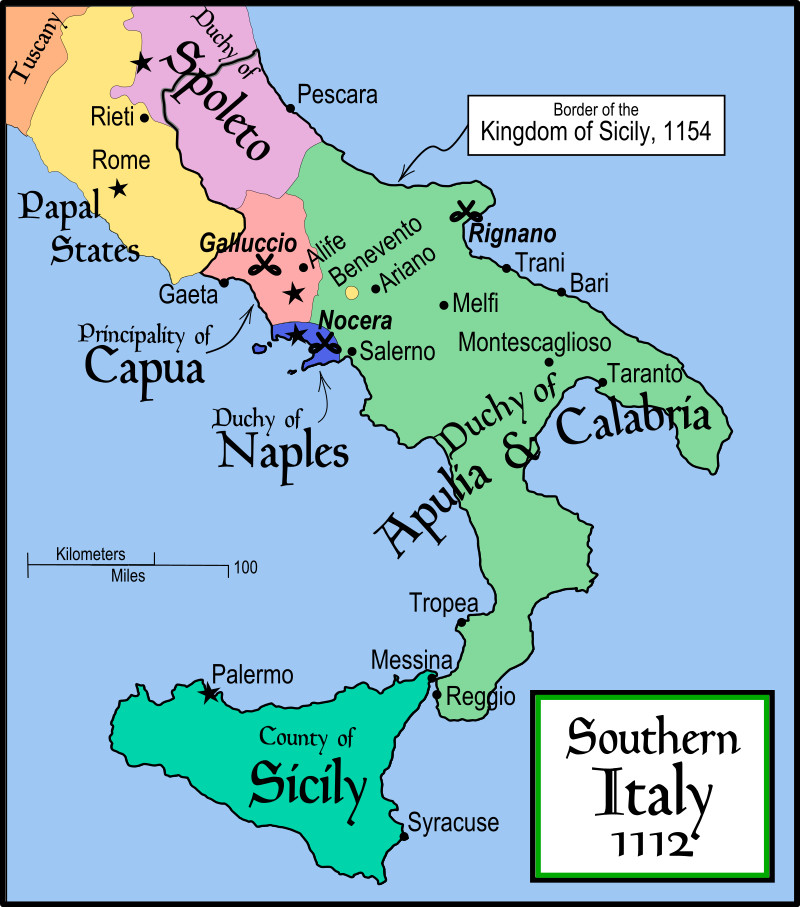Norman Kingdom of Sicily
Contents
Geography
Cities of Sicily
- Palermo -- medieval -- Capital of the New Kingdom of Sicily
- Syracuse -- medieval --
Locations of Interest
- Castel d'Ombro -- Better known as the "Castle of Shadows"
- The Lair of Nystor
History
Norman Conquest of Sicily
The Norman conquest of southern Italy lasted from 999 to 1139, involving many battles and independent conquerors. In 1130 these territories in southern Italy united as the Kingdom of Sicily, which included the island of Sicily, the southern third of the Italian Peninsula (except Benevento, which was briefly held twice), the archipelago of Malta and parts of North Africa.
Itinerant Norman forces arrived in the Mezzogiorno as mercenaries in the service of Lombard and Byzantine factions, communicating news swiftly back home about opportunities in the Mediterranean. These groups gathered in several places, establishing fiefdoms and states of their own, uniting and elevating their status to de facto independence within fifty years of their arrival.
Unlike the Norman conquest of England (1066), which took a few years after one decisive battle, the conquest of southern Italy was the product of decades and a number of battles, few decisive. Many territories were conquered independently, and only later were unified into a single state. Compared to the conquest of England, it was unplanned and disorganized, but equally complete.
Pre-Norman Viking activity in Italy
There is little evidence for Viking activity in Italy as a precursor to the arrival of the Normans in 999, but some raiding is recorded. Ermentarius of Noirmoutier and the Annals of St-Bertin provide contemporary evidence for Vikings based in Frankia proceeding to Iberia and thence to Italy around 860.
Some modern scholars have connected this event with a much later account by the infamously unreliable Dudo of Saint-Quentin, who has a Viking fleet led by one Alstingus land at the Ligurian port of Luni and sacking the city. The Vikings then move another 60 miles (97 kilometres) down the Tuscan coast to the mouth of the Arno, sacking Pisa and then, following the river upstream, also attack the hill-town of Fiesole above Florence and win other victories around the Mediterranean (including in Sicily and North Africa).[2] Building modern speculation on medieval invention, some scholarship has identified the leaders of this expedition as Björn Ironside and Hastein. Dudo's account, however, probably adds no historically reliable information to the brief contemporary annals.
Other contact between Italy and the Viking world occurred via Eastern Scandinavians coming to Italy via the Austrvegr (the river routes from the Baltic to the Black Sea) and working as Varangian mercenaries fighting for Byzantium. In particular, three or four eleventh-century Swedish Runestones mention Italy, memorializing warriors who died in 'Langbarðaland', the Old Norse name for southern Italy (Langobardia Minor). Varangians may first have been deployed as mercenaries in Italy against the Arabs as early as 936.
Arrival of the Normans in Italy, 999–1017
Sources
https://en.wikipedia.org/wiki/County_of_Sicily
